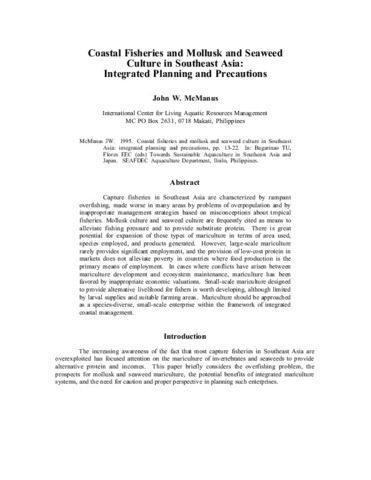Perlihatkan publikasi sederhana
Status and impacts of tilapia fish cage farming in Lake Bato: Some policy and management options for sustainable development
| dc.contributor.author | Nieves, Plutomeo M. | |
| dc.contributor.editor | Cuvin-Aralar, Maria Lourdes | |
| dc.contributor.editor | Punongbayan, Raymundo S. | |
| dc.contributor.editor | Santos-Borja, Adelina | |
| dc.contributor.editor | Castillo, Lourdes V. | |
| dc.contributor.editor | Manalili, Eduardo V. | |
| dc.contributor.editor | Mendoza, Marlynn M. | |
| dc.date.accessioned | 2021-07-27T06:53:33Z | |
| dc.date.available | 2021-07-27T06:53:33Z | |
| dc.date.issued | 2005 | |
| dc.identifier.citation | Nieves, P. M. (2005). Status and impacts of tilapia fish cage farming in Lake Bato: Some policy and management options for sustainable development. In M. L. Cuvin-Aralar, R. S. Punongbayan, A. Santos-Borja, L. V. Castillo, E. V. Manalili, & M. M. Mendoza (Eds.), Proceedings of the First National Congress on Philippine Lakes (pp. 179-192). Southeast Asian Regional Center for Graduate Study and Research in Agriculture (SEARCA). | en |
| dc.identifier.issn | 1656-8099 | |
| dc.identifier.uri | http://hdl.handle.net/10862/6136 | |
| dc.description.abstract | An assessment and impact analysis of the fish cage arming in Lake Bato was conducted from October 1999 to January 2000 through a field survey and personal interviews with fish cage farmers, operators and key informants in 10 lakeside communities bordering Lake Bato. Tilapia fish cage farming was the most dominant activity undertaken in the lake owing to its economic contribution and performance. It is sad to note, however, that the management and protection of the lake has been neglected. Results showed that the lake is experiencing serious stress and degradation as a result of fish cage congestion numbering to more than 21,820 units indiscriminately installed all over the lake. The same is also the cause of conflicts (i.e., marginalized small-scale fishers, obstruction of navigational route, and proliferation of dummy fish cage operators) among lake users. As a consequence of expanded technology application, slow fish growth, algal bloom, fish kill, and the apparent shallowing of the lake have become alarming concerns among resource users. It is also worth noting that the industry s sustainability is now under serious threat if not properly planned, managed, and protected. It is therefore recommended that alternative policy and management options be institutionalized. This would include formulation of a lake-wide inter-Local Government Unit (LGU) fisheries ordinance, implementation of Lake Bato Resource Management Plan, organization of a lake-wide fish cage farmers and operators, conduct of collaborative and interdisciplinary research and development initiatives, conduct of technical and management training for Best Fish Cage Practice, and massive information-education-communication (IEC) for concerned municipalities. | en |
| dc.language.iso | en | en |
| dc.publisher | Southeast Asian Regional Center for Graduate Study and Research in Agriculture (SEARCA) | en |
| dc.subject | Status and impacts | en |
| dc.subject | Fish cage farming | en |
| dc.subject | Policy and management options | en |
| dc.subject | Oreochromis niloticus | en |
| dc.title | Status and impacts of tilapia fish cage farming in Lake Bato: Some policy and management options for sustainable development | en |
| dc.type | Conference paper | en |
| dc.citation.spage | 179 | en |
| dc.citation.epage | 192 | en |
| dc.citation.conferenceTitle | Proceedings of the First National Congress on Philippine Lakes | en |
| dc.subject.asfa | cage culture | en |
| dc.subject.asfa | sustainable development | en |
| dc.subject.asfa | tilapia culture | en |
| dc.subject.asfa | impact assessment | en |
| dc.subject.asfa | policies | en |
| dc.subject.asfa | management | en |
| dc.subject.asfa | evaluation | en |
| dc.subject.asfa | production | en |
| dc.subject.asfa | marketing | en |
| dc.subject.asfa | economics | en |
| dc.subject.asfa | sociology | en |
| dc.subject.asfa | environmental impact | en |
Files in this item
| Files | Size | Format | View |
|---|---|---|---|
|
There are no files associated with this item. |
|||
Publikasi ini ada di koleksi berikut
-
LakeCon2003 [49]
Proceedings of the First National Congress on Philippine Lakes




